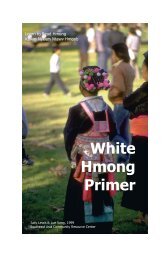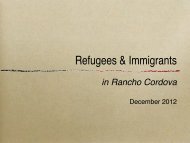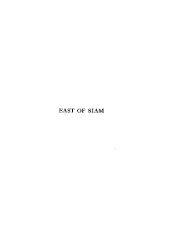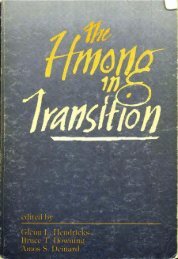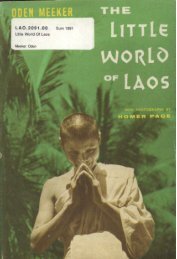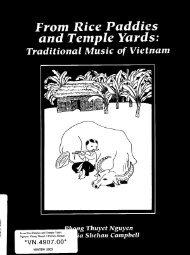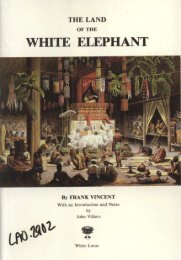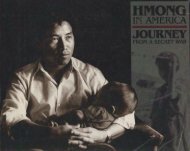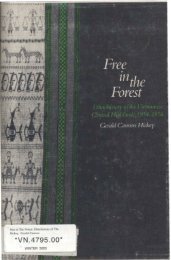PEOPLE
Grant, The Boat People - Refugee Educators' Network
Grant, The Boat People - Refugee Educators' Network
- No tags were found...
You also want an ePaper? Increase the reach of your titles
YUMPU automatically turns print PDFs into web optimized ePapers that Google loves.
TAB Boar Wuple<br />
toiy impul~es of attraction and repulsion that bind it to China. For<br />
a thousand yars (1 11 BC to AD 939) northern Vietnam was governed<br />
as part of a Chinese colony. During that urn the Vittname<br />
thoroughly abswkl Chinese cultural tfpdition while rebelling<br />
whenever they judged the power of a dynasty in China to be weak.<br />
Perhaps the most famous of the rebels were the Trung sisters, who<br />
led Vietnamest armies in a desperate stand against the Chinese in<br />
AD #43 and who had become goddesses in Vietnamese mythology<br />
by the twelfth century. (They were still being honoured in ceremonies<br />
in hh the communist north and the anti-communist south during<br />
the Vieman war,)<br />
After the Viemamest broke China's hold, annits from the north<br />
invaded many times (in 981,1075-77,1250 and 1280,1406-27 and<br />
1788) always ultimately unsucca6fully, This history of rejection of<br />
China, whih at the m e time drawing fram the daepcst resources<br />
of Chinese culture and paying appropriate homage to Peking, fostered<br />
the historial ideal that has sustained Vietnamese nationalism<br />
until taday: that a united Vietnam has always misted, that its<br />
antecedents are as venerable as China's and that its internal harmony<br />
can only be managed by a single ruler. Tfit ideal mler was one who<br />
could mist China while absorbing its &adition.<br />
As they mtablished themselvts in the mow, mountainous<br />
mnay shaped like the letter S, which stretches for 2000 kilometres<br />
nmh to mth and is only 50 kilometres wide at its narrowest point,<br />
the Vietnam= =me into conflict with their southern neighboun.<br />
The Hindu-Buddhist kingdom of Chnmp, which hd established<br />
itself on the nneal Vietnamese coast in AD 192 and hd at times<br />
held sway in southern Cambodia (sailing up he Mekong in 1177<br />
to sack Angkw), was eliminated after bitter wars. The Vietnamese<br />
pressed upon the Khmers, who were also h ~ w in d the west by<br />
the Thais. By 1672 the Vietnamese had pushed south to Snigon and<br />
from there they spread to occupy the Mtkong delta. CamMia paid<br />
tribute to the Vietnamese cwrt and for a while was incotpurated into<br />
Vietnam.<br />
The Vietnam also fought among themselves. A struggle for<br />
supremacy between the Trinh family in the north and the Nguyen<br />
Yr3.lily in the south Lted from 1620 until 17?7, during which the<br />
Nguyen built walls across the waist of Vietnam near the seventeenth<br />
parallel which kcme the dividing line between north and south in<br />
1954 (after tht Geneva agreements which brought French rule to<br />
an end). Vietnam was finally united in 1802 with three mdn regions,<br />
Tonkin (capital: Hanoi) in the north, Anmm (capital: Hue) in the<br />
centre and Coehin China (capital: Saigon) in the south.<br />
The Viemamtse mbsorhd little of the Hindu culture of their<br />
neighboun. Some influence of Cham music has been detected and<br />
Vietname generals used elephants, which are potent in Hindu lore,<br />
while the Chinese favoured horses, but this was probably simply<br />
kcause the elephants were more mobile and some accounts suggest<br />
the horses were afraid of them. But the Vietnamcst never adopted<br />
the symbol^ of Hinduism that had kcome established in South-East<br />
Asia - the lingam, the gum, the mountain-temple, Sanskrit, nor,<br />
indeed, religious tolmnce. Their smgth was a village-based<br />
society linked in the mind, especially of the peasant, with a higher<br />
order of values expressed in the Confucian idea of a governing Ctite.<br />
Their method5 were social integrntion, physical mptiw and plitical<br />
unity. They moved relentlessly ams8 the floodad rice fields<br />
of the southern delta and pcninaula, hwd-working and selfsuficienc,<br />
and it is probable, had the French not arrived, that they<br />
would have occupied a substantial pm if not the whole of what<br />
b m e known as Indo-China. On the other hand, of course, if the<br />
Vietnamese had not s t d against China, the Chinese might well<br />
have occupied all of Indo-China thernsclvts. This argument eontinues<br />
today in the contrary claims mmde by kkhg and Hnnoi about<br />
each other's intentions in South-East Asia,<br />
The first Europeans in Viemam (1535) were derb and missionaries<br />
and although the Dutch and the Portuguese meddled<br />
occasionally in the epic Trinh-Nguyen feud, European govmmtnts<br />
did not become interested in Vietn~m until the end of the eighteenth<br />
century. A missionary, Pierre Pigncau (dc Behaine), was respon9iblc<br />
for the first gestures of official French interest, He became a supporter<br />
of Nguyen Anh and journeyed to France in 1787 to plead his<br />
East at the court of Vmaillcs, With him, given as r pledge, was<br />
Nguycn's four-year-old mn and heir, Canh. The court, which was<br />
on the verge of the French revolution, gave little thought to the political<br />
worth of the priest's mission, although the boy cfeatcd excitement<br />
in the salons. However, a treaty was signed between Frana




